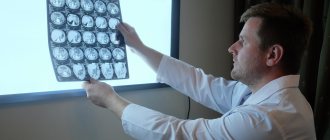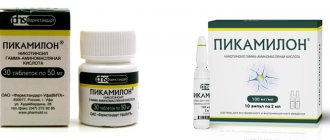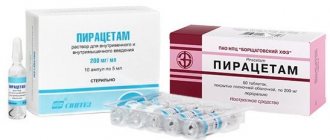Price list Doctors clinic
Echoencephalography or Echo-EG of the head is an ultrasound diagnostic method that is used to identify pathological processes and changes in the structure of the brain. It is based on the ability of tissues to reflect ultrasonic waves and has almost no contraindications due to safety. The method demonstrates indirect signs of pathological changes.
The examination takes no more than 15-20 minutes, does not cause pain or discomfort, which makes it popular when examining young patients. Quite rarely used in adult neurological practice.
Indications for Echo-EG
A therapist, neurologist or other specialist can refer you for echoencephalography for the purpose of primary diagnosis in cases of brain diseases or suspicion of them. One of the important reasons for the procedure is emergency cases (including TBI) that threaten a person’s life. The examination allows you to detect the following changes and disorders:
- volumetric brain lesions;
- foci of hemorrhage, intracranial hematomas;
- abscesses, purulent inflammation of tissues;
- indirect signs of intracranial hypertension;
- indirect signs of hydrocephalus.
Using echo-EG of the head, it is possible to assess the dynamics of treatment. Thus, the following symptoms and conditions may be the basis for the procedure:
- previous injuries and bruises, suspected concussion, hematomas, etc.;
- attacks of nausea not caused by pathology of the digestive system;
- dizziness, repeated fainting;
- noise in ears;
- decreased performance;
- paresthesia, tingling in the upper or lower extremities;
- sleep disorders: drowsiness, intermittent, superficial sleep, nightmares, etc.;
- frequent headaches;
- neurological reactions: enuresis, stuttering, tics, automatisms, etc.
The procedure can be prescribed for already identified diseases as a tool for monitoring the effectiveness of treatment. It can be repeated the required number of times without restrictions, unlike radiographic diagnostic methods. Echo-EG of the head can be performed after surgical interventions. In this case, it is important to wait for the skin to heal and then begin the study.
Echoencephalography can be the first diagnostic step and precede studies such as CT and MRI. In other cases, Echo-EG replaces these methods and serves as the only diagnostic method, for example, if there are contraindications to other examination tools.
What is Rheoencephalography (REG)?
Rheoencephalography is a diagnostic method based on graphic recording of electrical resistance of tissues. Along with ultrasound, REG is a safe method that has long been used in medicine. To carry out the procedure, electrodes are used that send impulses to the body tissues, the reaction to which is assessed by the device. REG allows you to evaluate the tone and elasticity of blood vessels, as well as nearby tissues. In addition, this method provides information about the filling of brain vessels with blood.
When is REG prescribed?
Typically, REG is prescribed to study large and small vessels of the brain in addition to ultrasound. Rheoencephalography is also indicated for an already diagnosed vascular problem to monitor the treatment of the disease.
How is the REG procedure performed?
Before the procedure, you must refrain from smoking, drinks and drugs that affect vascular tone. The patient must be at rest: the study is carried out in a lying or sitting position. Electrodes are attached to previously degreased areas of the head. The patient’s task is to remain still and calm, if necessary following the doctor’s instructions to carry out functional tests that increase the effectiveness of the study. The duration of the REG procedure is 15-30 minutes.
Order of conduct
No special preparation is required for echoencephalography. You can lead your usual lifestyle, there are no restrictions on diet or medication.
The procedure is performed in a lying or sitting position. It is important to keep the head still, so when examining the child, parents can be present in person and help the baby not move. A special gel is applied to the scalp to improve the conductivity of the ultrasound signal, then the doctor installs the sensors.
Depending on the tasks, a specialist can install one sensor or use two located on both sides of the head. The result of this diagnostic method is a graphic image that shows whether the midline structures of the brain are displaced or whether there is an expansion of the cerebrospinal fluid spaces.
How to properly prepare a child for research?
Without preliminary preparation, the research procedure may cause fear in young children due to the specific preparatory manipulations performed. Therefore, it is recommended that parents prepare their baby in advance. Young children can be prepared in a playful way, for example, by telling the child that he will try on the helmet of an astronaut, pilot or superhero. Older children need to be explained in detail how the EEG procedure will be performed, even shown if possible. With such preparation, children come for diagnostics with pleasure and are not afraid of anything, which guarantees a successful recording of the study.
What is Doppler ultrasound (USD)?
Doppler ultrasound uses the reaction of ultrasound to moving blood particles - red blood cells. The sensor transmits information to the monitor in real time, allowing the sonologist to judge the quality of blood flow and the circumstances that could affect it. Doppler ultrasound, like REG, is a non-invasive, painless research method, which better allows diagnosing vascular diseases in patients at any age and condition.
When is ultrasound ultrasound prescribed?
Doppler ultrasound, like REG, is prescribed for alarming symptoms indicating vascular problems of the brain: headaches, fainting, dizziness, memory and attention disorders. Most often, ultrasound examination is prescribed by a doctor as a primary research method to confirm or exclude a suspected diagnosis. In some cases, it is advisable to prescribe Doppler ultrasound of the vessels of the head and neck for diagnosed diseases that affect the body’s vascular system.
How is the ultrasound procedure performed?
In terms of duration and ease of implementation, Dopplerography differs little from rheoencephalography. To do an ultrasound scan, the patient will need to sit or lie down on the couch, after which the sonologist applies the sensor alternately to the temporal and occipital parts of the head, as well as to the eyes, where ultrasound reaches the vessels best - this way it is possible to examine almost all the vessels of the brain, as and in the case of REG.
In what cases is such an examination prescribed?
Symptoms for which a doctor may prescribe an Echo EG:
- periodic headache;
- feeling of dizziness, poor spatial orientation;
- ringing in the ears;
- head injuries accompanied by nausea or vomiting.
In addition, echoencephalography is prescribed to identify the causes of other pathologies:
- pain in the cervical region;
- vegetative-vascular dystonia;
- impaired blood circulation;
- vertebrobasilar arterial system syndrome;
- ischemic disease;
- brain concussion;
- vascular encephalopathy of the head;
- stroke.
An electroencephalogram shows the main parameters of cerebral functions. Using a head echo, a number of diseases can be detected. These include: various tumors, inflammatory processes, cerebral blood flow disorders, intracranial pressure, hydrocephalic syndrome, adenoma of brain areas.
results
Decoding Echo ES is the competence of a neurologist, diagnostician or neurophysiologist. Normally, it is believed that the signal from the first sensor should be identical to the signal from the second. A signal that deviates by 1-2 mm from the original value can be called pathological (an error of up to 3 mm in children is acceptable).
If the initial signal changes, it means that within the cranium there is a dislocation of structures due to a volumetric process, which can be:
- tumor;
- intracerebral hemorrhage;
- cyst;
- purulent abscess;
- tuberculoma;
- accumulation of parasites.
- volumetric inflammation.
However, different diseases have specific signs on the monitor:
- Tumors and cysts. They greatly displace brain structures compared to other brain diseases, and therefore increase the difference between the original and received signal.
- Trauma to the skull and brain. They show a difference of within 3mm due to the formation of edema. Later, injuries can provoke the development of cysts, which increases the difference between signals from 3mm.
- Acute cerebrovascular accident. Intracerebral hemorrhage makes a big difference. The value of the lateral echo signal increases due to the presence of a focus of hemorrhage in the tissue. Ischemic stroke, cerebral infarction and softening of brain tissue produce subtle signal differences.
- Hydrocephalus. This pathology produces a signal difference of more than 7 mm.
Follow-up diagnostics
Despite the fact that a head echo is a fairly accurate diagnosis, a specialist can only draw preliminary conclusions based on it. Making an accurate diagnosis is the task of the attending physician, who relies not only on the results of EchoCG, but also on other studies, as well as on the patient’s medical history.
Only additional methods, test results and studies prescribed by the doctor can confirm or refute the preliminary diagnosis received from the Echo EG specialist.
Echoencephalography is an innovative and highly informative method of examining the head. There are no contraindications to its use, it is painless and absolutely safe. Therefore, when prescribing this form of diagnosis by a doctor, you should not ignore the procedure.
Decoding the research results
The results of interpretation of Echo EG of the brain in adults and children do not differ. The procedure is performed by a sonologist.
Normally, the examination consists of three bursts, which are called complexes. The initial burst is a signal generated by ultrasound. Ultrasound is reflected from the bone tissue of the skull, skin and brain tissue. The median burst (M-echo) is a complex that is obtained when ultrasound comes into contact with the structures of brain tissue located between the two hemispheres.
The final burst is a signal that comes from the tissues of the cranial bones and the dura mater of the brain on the other side of the probe. The connection between these three complexes is projected onto the monitor screen and represents a graph with axes. The specialist prints the results on paper and begins decoding.
How are the results and detected pathologies interpreted?
The diagnostician makes a conclusion based on three sets of bursts:
- initial It is formed due to sound waves that are reflected from the bones of the skull, skin, superficial structural tissues of the organ,
- average, formed on the basis of waves reflected from brain textures between the hemispheres,
- terminal - indicators identified by wave reflection from the meninges and soft structures.
The device displays all three complexes on the screen in graphical form. The diagram is deciphered by a specialist in several stages:
- The M-echo signal is the highest amplitude intercomplex signal. The distance from this indicator to each cerebral hemisphere should be identical. The minimum error within the standard is acceptable,
- The growth of the average stage indicator is not the norm. Deviations from the mean indicate intracranial hypertension,
- M-signal pulsation cannot be higher than normal. Otherwise, doctors also talk about the patient’s tendency to hypertension,
- in the interval between the initial and final signals, light, low-amplitude impulses should appear, their number should not change,
- if the midsellar impulse is lower than 3.9-4.1, it is concluded that the patient has high intracranial pressure.
Neoplasms and hematomas
A significant shift in the M-echo indicates a high probability of neoplasms and hematomas of the organ. Cancer cells produce more significant displacements than benign tumors. The size of the deviation may also indicate the presence of pathology. If it is located in the middle section, then minimal displacement is possible, or it is not observed at all.
Meningoencephalitis
This pathology is inflammation caused by microorganisms. The disease is transmitted by ixodid ticks. On EchoEG, the disease shows itself as a data shift. If the deviation value is high, an abscess may be present.
Hydrocephalus (dropsy)
Hydrocephalus, or dropsy, is formed due to the accumulation of cerebrospinal fluid in a large volume. The device shows pathology with a large number of signals between all complexes. The index of the third ventricle is less than twenty-two, while the norm is from twenty-two to twenty-four.
Intracerebral hemorrhages
With this pathology, numerous additional signals are noted in the affected hemisphere.
REG and USDG: what is the difference?
REG allows you to assess the tone, elasticity and blood supply of blood vessels, and reveals many pathologies of the brain. In addition, REG allows you to determine whether pathologies are functional or organic in nature. Doppler ultrasound makes it possible to judge pathologies by indirect signs: vascular patency, trajectory and speed of movement of red blood cells. REG is based on the electrical resistance of blood vessels and tissues, which is why it differs from Doppler ultrasound and other methods of ultrasound examination of the brain
.
What is EchoEG
A beam of sound waves with a frequency of 0.5 to 15 MHz/s penetrates tissue, meninges, blood, cerebrospinal fluid and is reflected on their surfaces. During the study, purulent inflammatory processes, foreign bodies, hematomas, and neoplasms can be detected. Diagnostics are also carried out to study arteries and veins, as well as to assess the patency of the lumen, tone, and elasticity of blood vessels.
With the help of EchoEG, doctors identify the causes of impaired blood circulation, which provoke the development of many serious diseases. The study is carried out in one-dimensional and two-dimensional operating modes. In the first case, the diagram on the monitor displays the midline structures of the brain, in the second, a flat two-dimensional cross-sectional image of the brain is displayed on the screen.








